It is an irony when Dumaguete city lands on the national consciousness, but for the wrong reasons.
Dumaguete is one of the least controversial cities of the country, and rightly so. It is known for Silliman University (1901), one of the country’s most prestigious centers of higher learning. Even if you take out Silliman (which we can’t, of course, because it is an asset), Dumaguete is simply charm and charisma: the ornate belltower and stone cathedral of St. Catherine of Alexandria, built in 1776, has one of the longest naves in the country. Jose Rizal had set foot in Dumaguete on August 1, 1896, while he was enroute to Dapitan. Urban legend says it was the national hero himself who had coined Dumaguete’s sobriquet: the place of gentle people.
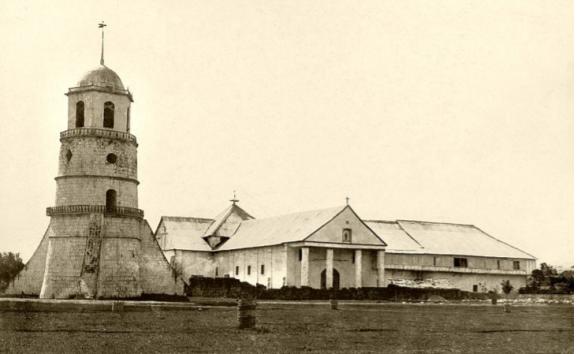
1891 photo of the Dumaguete Cathedral, Philippine Digital Archives, University of Michigan
Today, Dumaguete is a jump-off point to several tourism attractions: the old world exoticism of Siquijor and its sorcery culture; Apo Island and its diving sites; dolphin-watching in Bais, Negros Oriental; the highland town of Valencia; and the archaeological site Bacong, where Philippine Metal Age pottery have been unearthed.
But on top of all these is Dumaguete’s crown jewel: its seaside rambla named Rizal Boulevard simply because Rizal had once taken a stroll there. Not only is it a captivating sight and a view deck of the Cebu and Siquijor islands. The boulevard and its stately tree canopies and old-world lampposts is a gathering place of local folks for leisure and recreation. Today is probably one of the last times to view the famous promenade. And that is because we are a country that kills our heritage vista corridors.
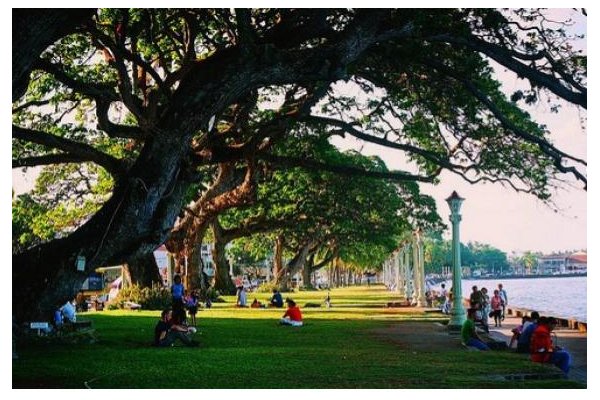
Photo from www.dumagueteinfo.com
Mayor Felipe Antonio B. Remollo is building an island across the boulevard. To be called Smart City, the 174-hectare mixed use development island to be reclaimed from the sea will have “2 waste water facilities, will be 5G ready and have underground cables, and will be situated 30 meters away from Rizal Boulevard which remains to be navigable between the present coastline and the offshore reclamation and every 2 kilometers within the reclaimed area. There will be no structures fronting the Rizal Boulevard, Pier Area and Silliman beach.” The project cost is 23 billion pesos to be shouldered exclusively by the proponent.
“The City and National Governments will own 51% of total land area generated by way of reclamation. The City will have 25% share in the ancillary businesses that the developer will put up like yacht club, terminal, market, parking, malls, etc. The city will earn tremendous revenues from business taxes, real property taxes from locators to support its social-economic and infrastructure programs such as mass housing, free hospitalization, food and utilities subsidy.”
On the section of the city mayor in the city government’s website, this line is repeated: “it will not obstruct the view from the Rizal Boulevard, Pier Area, and Silliman Beach.”
The opposition is formidable. Foremost of all is the non-negotiable statement released by the Board of Trustees of Silliman University on July 20, 2021. “For the past 40 years and up to the present, Silliman has been a leading institution in marine conservation in the Philippines. Studies made by Silliman scientists have determined that reclamation projects, such as the one being currently proposed by the City Government of Dumaguete, will cause damage and disruption of marine ecosystems not only in Dumaguete City, but also in adjoining areas.”
And then there is the booming voice of opposition if it comes from a proclaimed National Scientist who happens to be a former secretary of environment and a former president of Silliman U. Dr. Angel Alcala signed a petition together with SU president Dr. Betty McCann and former president Dr. Ben Malayang III, who is also an environmentalist. “The project will directly destroy, literally bury the few remaining coral reef, seagrass, and soft sediment ecosystems that support small-scale fisheries and gleaning in Dumaguete.” And then it makes an unequivocal call to the city council to disclose its reasons for the “haste” in pushing the project in the light of the coming elections.
Bishop Julito Cortes of the Diocese of Dumaguete wrote the developer E.M. Cuerpo Inc. on July 12 to express that it “must consider the scientific and environmental implications, not to mention its impacts on the cultural and moral life of the people in the local community.” Cortes has also called for the tolling of bells of St. Catherine of Alexandria Cathedral at 3 p.m., and for the praying of the Chaplet of the Divine Mercy and Pope Francis’ “A Prayer for our Earth.”
The issue has skyrocketed to national proportions. Paulo Alcazaren (credentials: environmental planner, urban designer, landscape architect) calls it a “prelude to disaster … It will negatively affect the hydrology of the bay, compromising outflows from the creeks and rivers and causing accretion of sand and garbage in corners … a harbinger of things to come.”
Alcazaren challenges: “Environmental heritage is a legacy to future generations.
“If Dumaguete pushes through with the 174-hectare reclamation (as indicated in a graphic released to the public) it appears that the island will block flows of stormwater from already-compromised catchments and silted waterways of the city. This flood risk map (produced by the city) shows an exacerbated flood risk will come from blocking about six waterways. Note too, from the satellite map how much land the city still has for planned development.”
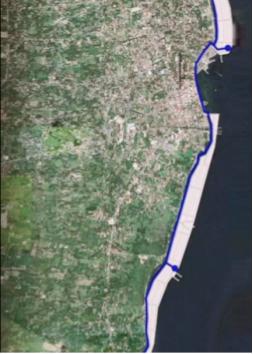
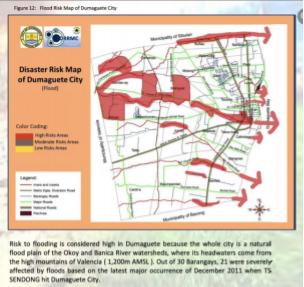
Paulo Alcazaren’s presentation of the flood risks the reclamation will pose
Netizens have joined the chorus of voices. The Facebook group Yes the Best Dumaguete has released a photo taken of coral reefs off Piapi Beach last July 17, 2021, approximately 50 meters from the shore.
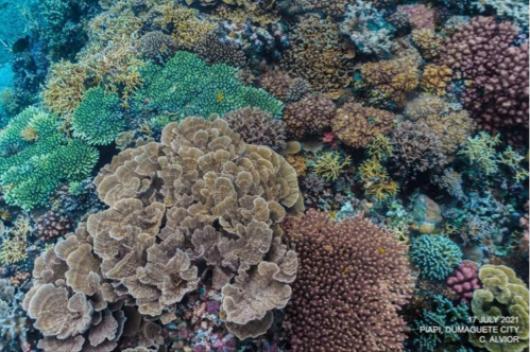
Photo by Clint Alvior posted in the Facebook group Yes the Best Dumaguete
The burning questions in the minds of many is, will Mayor Remollo listen to opposing voices and heed the call of expert scientists?
The views in this column are those of the author and do not necessarily reflect the views of VERA Files.